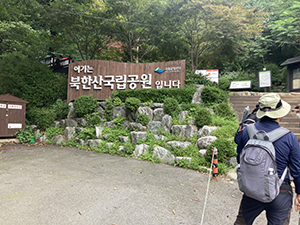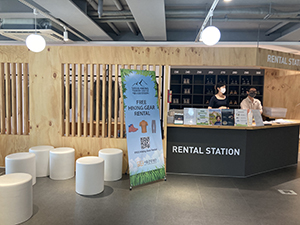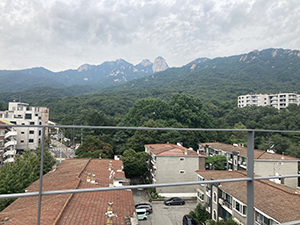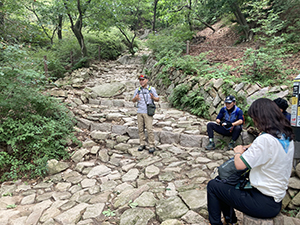Recommended travel
-

[Hotel Pack] #Signiel Seoul #Blue House #National Park Bukhansan #Seoul Free Travel #Seoul Hiking #Seoul City Climbing Tour
SIGNIEL SEOUL
The Blue House, meaning “blue roof tile house,” was used as the presidential residence for the first to 19th presidents of the Republic of Korea to live and perform official duties. It was completely open for viewing.
Bukhansan National Park, which is a rare natural park in the city center in the world, was designated as Korea’s 15th national park in 1983.was designated as It has an area of 76.922㎢ and is divided into the Dobongsan region to the north and the Bukhansan region to the south with Uiryeong as the boundary. Bukhansan National Park forms beautiful valleys with sheer rocky peaks in various places as the granite ground has been eroded and weathered over many years. In addition, you can see numerous historical and cultural relics including Bukhansanseong Fortress with 2,000 years of history. SIGNIEL Seoul is located on the 76th to 101st floors of Lotte World Tower, the tallest building in Korea. You can see the panoramic skyline and fantastic night view of Seoul from (235 rooms). As the only hotel in Korea where you can enjoy the sunset and sunrise in one place, the banquet hall with state-of-the-art facilities located on the world's highest floor offers delicate and elegant services unique to SIGNIEL SEOUL. It is a hotel that exceeds expectations and provides value beyond anything you can imagine.travel area Blue House &National Park Bukhansan Hotel name/room type SIGNIEL SEOUL/GRAND DELUXE DOUBLE check in/out 15:00~11:00 number of guests 2people product price 620.000won
Detail
Seoul Recommended Spot
a recommended trip
■ Cheong Wa Dae & National Park Bukhansan Mountain
Hotel Name/Grade - Signiel Seoul / Number of 5-Star Rooms - 235 Ancillary Facilities - Sauna Fitness Center Swimming Pool Restaurant - Restaurant Bakery Lounge Bar Banquet Hall - Convention & Wedding Wi-Fi - Free use of all rooms
▶ Guest room type & width-Grand deluxe double room 40-50㎡
Room Type-Grand Deluxe (Double only)/Premier/Signiel Premier
Additional charge- Riverview/Sinic Bess- Extra bed with additional people-
▶ This product includes breakfast buffet
Breakfast fee 50,000 won for adults - 30,000 won for children (four years old~)12 years old)
★ Application period - December 22, 2022
Applicable Charges - Sunday to Thursday
Specific Period - Friday Saturday
★ 10% service charge and 10% VAT will be added to the breakfast charge of the room.
Twin types are available from Premier and above.
There is no family-to-win type. (Additional extra bets can be used for 3 people)
■ Room Use Customer Privilege
★ Free use of Salon D Signiel (Guest Lounge) on 79F. Free access for up to 2 guests. 50,000 won per person (tax!0% and service charge 10%)
★Fitness on the 85th floor, free use of the swimming pool. Twin rooms are available above Premier. There is no family twin room type. (Additional bed can be used for 3 people.)
▶ subway information
986m from Exit 3 of Gyeongbokgung Station on Cheong Wa Dae-3
National Park Bukhansan-Ui New Line Exit 2 of Bukhansan Ui Station
▶ Nearby tourist attractions
Cheong Wa Dae-Gyeongbok Palace, Gwanghwamun Square, Sejong Center for the Performing Arts, and around City Hall
Bukhansan National Park - Doseon Temple
■ Product reservation progress information
Please contact us first and then the payment will proceed once the reservation is completed.
We are informing you after checking the availability of hotel reservations.
★ Precautions for payment
Please make sure to contact us and proceed with the payment.
Please pay after receiving confirmation of room reservation from the person in charge of reservation for Samsam Tour.
You must use the corporate account of Samsam Tour Co., Ltd. and the Samsam Tour payment system for all payment methods of the trip, and you cannot receive legal protection if you use other payment methods.
※ Included/Not Included/Informational
Included Details - Hotel room rate 1 night and breakfast buffet 1 time
Not Included - [Transportation] Vehicle* Oil Feea round-trip air ticketDinner. Other snacks
Domestic Basic Traveler Insurance
[Other] Personal expenses such as admission fees to tourist attractions
★ Product terms and conditions
The special domestic travel terms and conditions apply to reservations and cancellations of this product.
A cancellation fee higher than the standard terms and conditions may be charged when applying the special night hall, and in this case, the consent process is sought.
⚫ Down payment regulations
When booking this product, you have to pay 50% of the product down payment and pay the remaining amount 15 days before the departure date.
⚫ Regulations for cancellation and reservation change fees
Please understand that this travel product is a three-piece advance of the hotel cost, and the cancellation fee below will be applied for cancellation or reservation change.
☞ Precautions for travel
[Not eligible for domestic traveler's insurance]
All domestic travel products departing from August 7, 2014 have been changed to include traveler's insurance as personal information (resident registration number) cannot be collected under the Personal Information Protection Act (restriction on the processing of resident registration numbers). However, we would like to inform you that transportation (air, rail, ship, bus-only vehicles, etc.) used during the itinerary have separate insurance.
If you want to sign up for traveler's insurance, we recommend you to sign up individually.
◆ Precautions for reservation
1. When notified 11 days before the start of the trip (~11): deposit refund 2. When notified 10 days before the start of the trip: 10% compensation of the travel fee 3. When notified 8 days before the start of the trip: 80% compensation of the travel fee (~11): 90% compensation of the travel fee 5. When notified on the day of the travel fee
취소Cancellation or change is only possible during business hours (09:00-18:00).
토You cannot cancel or change on Saturdays, Sundays, and holidays. (Closed on weekends and holidays)
◆ Guide/leaders and meeting information
Guide, Leader-This product is a free trip and does not have a guide.
Meeting information - This product is a free trip, so there is no meeting.
▶ itinerary
★ Reservations are required for viewing the Blue House from 09:00 am to 10:30 am during the morning-Cheonghwadae viewing time.
☞ Every Tuesday – Closed regularly
Cheong Wa Dae Reservation: https://www.reserve.opencheongwadae.kr/
★ P.M.-National Park to Bukhansan Mountain
itinerary
a visit to the Blue House



Reservation in the morning (09:00-10:30 or 10:30-12:00)
1 Entrance to the Spring and Autumn Hall entrance
Completed in 1990, the Chunchugwan was designed to serve as a press conference room for the president and reporters.The name Chunchugwan originated from Chunchugwan and Yemun Chunchugwan, the government offices that used to record historical records during the Goryeo and Joseon Dynasty, and was adopted to symbolize the spirit of today's free press.Chunchugwan has a traditional elegant look with earthenware on its gabled roof to match the surrounding landscape.
2. Green Garden
It is the most beautiful place in the precincts of the Blue House, with 120 kinds of trees and commemorative trees of previous presidents.During the Joseon Dynasty, it was used as a place to see the past of literature and dance as a sponsorship outside the Sinmu Gate of Gyeongbokgung Palace, and later as a garden, it was used as a site for livestock breeding and greenhouses.It was also used as an outdoor venue, and various events were held every spring, including Children's Day, Parents' Day, and Disabled People's Day.In addition, there is a Korean pine tree called Bansong, which symbolizes green support, which is about 150 years old and is 16m high.
3. Sangchunjae (Sangchunjae
It was used to introduce Korean housing styles to foreign VIPs visiting Cheong Wa Dae, to ceremonial events, and to hold informal meetings.Currently, there was Maehwasil ( 매관인), an annex to the government-general of the Joseon Dynasty during the Japanese colonial era, and it was renamed Sangchunsil (室)春) under President Syngman Rhee, and it was renovated into a wooden building with a natural slate roof in March 1978.Since then, it has been named Sangchunjae, and in April 1983, it was newly built as a traditional hanok-style house with a total floor area of 417.96㎡.
4. the official residence
The presidential residence where the president and his family live was built to distinguish between the president's public and private work spaces.The main building, a living space, and a detached house, a reception event space, are arranged, and in the front yard, a traditional Korean-style garden and a detached house are located.The gate is made of a three-door gate that fits the atmosphere of a traditional hanok.As a traditional wooden structure, it has an L-shaped roof with Korean blue roof tiles on top of the double eaves of the Paljak roof, a palace architectural style.
5. Water Palace Site
The current location of Cheong Wa Dae was sponsored by Gyeongbokgung Palace during the Joseon Dynasty.When Gyeongbokgung Palace was rebuilt in the 5th year of King Gojong's reign, buildings such as Yongmundang, Yongmudang, and Oungak were built, and past tests and martial arts competitions were held.The current Sugungteo site was the site of Sugung Palace, which protects the royal palace at that time. During the Japanese colonial period, the Japanese Government-General of Korea built an official residence for the governor at this Sugung site, and after liberation, it was also used as a residence for Lieutenant General Ha of the U.S. Military Government.After the establishment of the Korean government, the name was changed to the Gyeongmudae and Cheong Wa Dae, and it was used as the presidential office and official residence.After the main building of the Blue House was newly built in 1991, the building was demolished and restored as a water palace site in November 1993.
6. Main building
Located in the south-facing direction of Bukaksan Mountain, the main mountain of Seoul during the Joseon Dynasty, the main building is a central building used for the president's office and interviews with foreign guests.It was newly built on September 4, 1991 after it was argued that it was not desirable internally and externally to use the place where the governor-general of Joseon lived during the Japanese colonial period as the presidential office and official residence. Based on the traditional wooden structure and palace architecture, the hipped-and-gabled roof was erected, which is the most elegant and beautiful, and a total of 150,000 Korean blue roof tiles were added. Single-story detached houses were placed on the left and right sides of the main building on the second floor.
7. Guest House
It is a building that held large-scale meetings and official events for foreign state guests. It was also used as an official venue for folk performances and dinners to promote Korea when foreign presidents or prime ministers visited, or as a venue for large-scale meetings and banquets for more than 100 people.Construction began in January 1978 and was completed in December of that year, with 18 stone pillars supporting the entire building, and the interior is shaped with Mugunghwa, laurel, and Taegeuk patterns symbolizing Korea.There are the same halls on the first and second floors, and the first floor was used as a reception hall for foreign state guests, and the second floor was used as a venue for large-scale luncheon and dinner events.
8. The Chilgung
Chilgung Palace is located in the southwest of Cheong Wa Dae, where the ancestral tablets of the concubines who gave birth to the king during the Joseon Dynasty are enshrined. There are Yukseonggung Palace (Sukjong's concubine Choi), Jeogyeonggung Palace (Seojo's concubine Inbin Kim), Daebunggung Palace (Sukjong's concubine Jang), Yeonhogung Palace (Yeongbin Lee), Seonheegung Palace (Yeongbin Lee), Gyeongsanggung Palace and Chiljo's concubine. Since 1968, it has been banned from the public, but it has been reopened to the public since November 24, 2001.Since visitors were able to visit the Chilgung Palace, visitors used to watch the Chilgung Palace in connection with the existing Cheong Wa Dae viewing.
9. Mugunghwa Garden
Mugunghwa Garden is a civic rest park located on the site of the former Central Intelligence Agency's safe house in Gungjeong-dong.Originally, this place was banned from entering the Blue House, but it was created as a civic park after the road in front of the Blue House was opened in 1993.Various trees and wildflowers are planted along with the national flower Mugunghwa in the park, and there is a fountain on the opposite side, making it a resting place for tourists visiting Cheong Wa Dae and nearby residents.
▶ Mountain climbing in Bukhansan National Park after lunch



Bukhansan National Park is a natural park in the city center, which is rare in the world. It was designated as Korea's 15th national park to fully preserve beautiful natural scenery and cultural resources and provide pleasant exploration services.It occupies an area of about 76.922의 across Seoul and Gyeonggi-do, and is divided into Bukhansan Mountain in the south and Dobongsan Mountain in the north, centering on Uiryeong Pass.



Bukhansan National Park is mainly composed of granite intruded during the Mesozoic Era. The granite ground that makes up Bukhansan Mountain appears in various unknown forms such as Bornhardt, Thor, plate joints, vertical joints, tafoni, gnama, and grooves as weathering and erosion over time. Geologically, the granite ground has risen and eroded since the Paleozoic Era, and it was formed about 200 million years ago by the Daebo Mountain Movement in the middle of Jurassic Period of the Mesozoic Era.



Bukhansan National Park's representative geological attractions are located along ridges and valleys such as Insubong Peak, Samobawi Rock, and Gucheon Valley, providing various attractions and becoming the best outdoor geological education venue in the metropolitan area. Seoninbong Peak, Jaunbong Peak, Manjangbong Peak, Uiam Peak, and Obong Peak, created by huge granite, create a spectacular view as the representative peaks of Dobongsan Mountain.



As such, Bukhansan National Park has dozens of clear and clean valleys formed between major rocky peaks made of huge granite, creating harmony between mountains and water, and 1,300 species of animals and plants live in a beautiful natural environment. In addition, numerous historical and cultural relics, including Bukhansanseong Fortress, which has a history of 2,000 years since the Three Kingdoms Period, and about 100 temples and hermitages are located everywhere to provide various attractions, ecology, culture, and history learning places.



In addition, Bukhansan National Park plays an excellent role as a "green lung" for urban areas. It is also widely used as a natural resting place for 20 million residents in the metropolitan area, and it is an easy-to-access transportation system and a huge background city with an average of 8.65 million visitors (as of 2009), making it the "national park visited by the most visitors per unit area."



⚫ All services are free for foreign tourists at the Seoul Metropolitan City Climbing and Tourism Center.
In particular, when climbing Bukhansan Mountain in the national park, the Seoul Metropolitan City Hiking Tourist Center is actively used
I recommend this book!
Exit 2 of Bukhansan Ui Station on the subway, turn left, and go straight 300m to the right
Seoul City Climbing Tourist Center on the 5th floor of the Lim Building (52, Samyang-ro 173-gil, Gangbuk-gu, Seoul)
BAC 5th floor)
Here is the schedule of the National Park Bukhansan Fam Tour hosted by the Seoul Tourism Foundation.
August 19, 2022 (Fri) 09:30 - Arrive at the Seoul City Climbing Tourism Center
■ Family tour schedule
Changeover-Center Introduction-Vehicle boarding-Baekwoon Exploration Support Center-Yeongbong (mountain climbing)-Hasan-(vehicle boarding) Do shipping parking lot-Center arrival-Changeover-shower-meeting (meal)
Meeting with the Head of the Seoul Center for Mountaineering and Tourism
Introduction of the center after changing clothes
①It provides attractive information on hiking tours in Seoul through the operation of multilingual (English, Chinese, and Japanese) information services for foreign tourists. It also provides promotional materials such as Seoul Tourism Guidebook maps.
②It provides rental services for hiking items (climbing, hiking clothes, etc.) to foreign tourists who visit the hiking tourism center in downtown Seoul.
Reservation for rental service: https://www.millim.in/en/goods/view/WQZEK-6892
③You can use the rest lounge in the center to prepare before hiking, and you can also leave memories with friends, family, and acquaintances who visited the photo zone together.
④The Seoul City Mountaineering and Tourism Center provides a variety of convenience facilities and services. There was an explanation that changing rooms and shower facilities are available, and coin lockers are installed so that luggage can be stored.
⚫ Arrive at the pilot - board a large bus prepared by the Tourism Foundation and move to the pilot
After arriving at Doseonsa Temple, you will receive detailed information on Bukhansan Mountain from a professional mountaineer, and precautions for hiking, warm up with light exercise, and start hiking on Baegundae Trail!
⚫ The hiking trail to Yeongbong Peak is a hiking trail with round stones and rocks of different shapes, and water flows down from the valley right next to it, making it a great place to take a break on the hiking trail. It's a national park, so the hiking trails are well organized, so it's safe.Bukhansan Mountain does not have a dangerous section, so you can climb it with sneakers and tracking shoes
During the brief break after arriving at Harujae, I could hear a lot of information about mountain climbing from a professional mountaineer.
About an hour after departure, I arrived at Yeongbong.
Dobongsan Mountain and Obong, which can be seen to the north, also look great very close.

⚫ Professional mountaineer's explanation continues while looking everywhere. Bukhansan Mountain Yeongbong Spirit (604m) is the best peak where you can see Insubong Peak, a mecca for rock climbing in Korea. It is said that the memorial monument for mountaineers who died during the surrounding climb, including Insubong Peak, was erected toward Insubong Peak, meaning "a resting place for the souls of mountaineers." These monuments are said to have been relocated to Mudanggol near Doseonsa Temple and formed as a joint memorial park.The fastest way to climb Yeongbong Peak using the Baegundae course is to go down to Doseonsa Temple, and when you go down, you can go straight down without a break. After arriving at Doseonsa Temple, taking a large bus prepared by the Tourism Foundation, taking a shower at the B1 of the city's tourist center, returning hiking, hiking clothes, and bottoms, carrying a bag stored in a locker, moved to nearby places for lunch, and ate delicious food prepared for a meeting.



